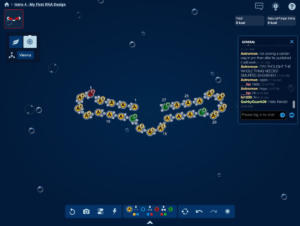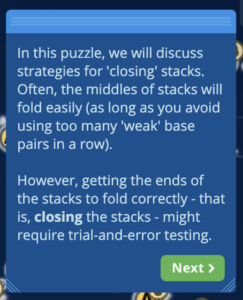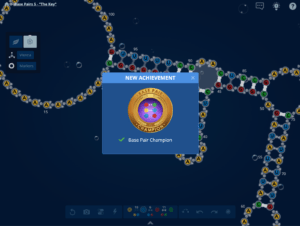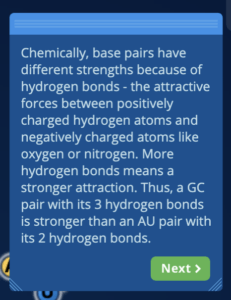EteRNA, by Jeehyung Lee, is a game about RNA folding.

The type of fun involved in the game is primarily challenge and expression, as it’s a puzzle-based game with multiple ways of solving each puzzle that allow the player to flex their creative muscles and express themselves. Optionally, players can engage in a fellowship type of fun by toggling open the live chat that allows them to discuss the game with other players, but since the other players aren’t necessarily friends and aren’t necessarily working on the same puzzle/space, the effect of this kind of fun might be kind of limited.
Within the MDAO framework, we see the following connections:
Mechanics: The mechanics include the RNA molecule at the center of every puzzle, the 3 different base pairs (with a “palette” that allows you to choose different ones), the differing strengths between the base pair bonds, the target folding of the RNA (if you achieve this, you’ve solved the level), and the natural folding of the RNA (the current state, which you adjust to get to the target folding).
Dynamics: Dynamics that emerge from these mechanics include trial-and-error, as sometimes you need to poke around the molecule and try things out, toggling between the natural and target views to understand how to solve the puzzle. In fact, the in-game tutorial encourages trial and error as a valid technique (see photo below). They also encourage dynamics and strategies like identifying core structure patterns in the target fold (like stacks and loops, again below), and starting with trying to get these structures first before filling in the rest of the puzzle.

Aesthetics: The game inspires a feeling of confidence as players complete each puzzle, playing sounds, doing animations, and including badges as players solve a level.. As players work through the game and read the accompanying descriptive text bubbles, players also gain a sense of growth and intelligence as they learn more about the real-world properties of RNA.

Outcome: The desired outcome of the game is presumably that the player has learned about RNA structures, with higher-level players actually being able to contribute to real-world science developments as their solutions to puzzles are passed to labs to be tested in real-world medical applications. As someone who was able to skip taking the second half of bio in high school (long story), I had no prior knowledge about RNA and was pleasantly surprised by how much I was able to learn in playing just a couple levels of the game. While the in-game text bubbles were a little lengthy at times (which made me want to skip through them to just get back to the puzzle, see below), they contained valuable information that explained all the parallels between the gameplay and the real world.




